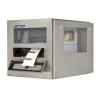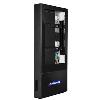The Future of Indoor Digital Signage and the Benefits for Businesses

The lights haven't gone out for indoor digital signage, despite the way that outdoor displays seem to dominate DOOH news.
In fact, indoor displays still hold the largest market share by volume.1
That's because indoor digital signage offers proven benefits for businesses looking to boost customer engagement. At the same time, improved technology makes it easier to use, drives down prices and brings futuristic functionality to workplace and consumer environments.
Let's look at the evidence for its place in your business and consider what the future of indoor digital signage holds.
Four Reasons to Invest in Indoor Digital Signage
1. It Might Be Your Only Choice
Outdoor digital advertising might not be possible for your business.
Some American states ban digital billboards, and many locations require you to obtain a zoning permit to install one.2
Even if that's not the case, the physical location of your store might cause practical barriers. For instance, stores located in a mall, or those competing with others for outside space, might find it difficult to use outdoor displays.
In these instances, indoor digital advertising becomes your best option, allowing you to use digital displays as creatively as you want.
2. It Benefits Businesses and Customers

Indoor digital signage delivers a range of brand-boosting benefits: 3
- It encourages customers to spend 30% longer in stores.
- It reduces perceived waiting times at checkouts by as much as 35%.
- It leads to a 31.8% increase in sales volume.
- It increases average purchase amount by 29.5%.
Indoor digital signage delivers benefits for consumers, too:
- Self-service kiosks allow customers to browse digital catalogues and make purchases without waiting for a salesperson.
- Digital menus reduce queues in fast food restaurants.
- Touch screen wayfinding displays provide intuitive, gesture-controlled maps that help users get where they're going quicker.
Indoor digital signage is an increasingly important part of consumer environments, delivering a better customer experience and boosting revenue for your business.
3. It's Increasingly Cost-Effective
The cost of digital displays is falling. New manufacturers and models continue to flood the market, driving down prices and making high-quality screens more accessible than ever.
Improvements in technology also reduce the price of last-year's models, making it possible to get outstanding displays at less cost.
You can even keep costs low in hazardous environments: An LCD/LED enclosure protects an ordinary screen in a robust, vandal-proof body, so you don't have to spend money on purpose-built public displays.
You can get started with indoor digital signage for less than you might think, which helps you receive a great return on investment as quickly as possible.
4. It's Getting Smarter

More on this in the next section, but indoor digital signage is getting smarter:
- Reactionary content can change according to real-world conditions, allowing you to advertise umbrellas when it's raining and sunglasses when it's not.
- Facial recognition cameras and artificial intelligence (AI) can identify customers and display the most relevant content according to variables like age and purchasing history.
- Analytics functionality allows you to track how people engage with your signage, helping you improve the effectiveness of your content.
Smarter displays promise a better experience for consumers and increased revenue for businesses.
Lots of these features depend on the media player and software you're using, meaning you can incorporate this technology into your existing digital signage without investing in new displays.
The Future of Indoor Digital Signage
Not only is indoor digital signage still going strong, it's advancing year on year as technology delivers better visuals, more-immersive experiences and new analytics functionality.
Display Technology Will Keep Getting Better
If you struggle to keep up with advances in display technology, then you're not alone. The race between manufacturers to create the biggest and brightest screens will continue to define the future of indoor digital signage.
In practice, expect a shift from LCD to LED displays, driven by the rapid development of a variety of cutting-edge LED technology.4
That's not to say that LCD displays are done and dusted, as they're expected to retain the largest market share for a while.5 Nonetheless, the investment of the big brands in LED technology indicates the beginning of the end for LCD's dominance.
At the same time, displays will continue to get slimmer and come in a greater variety of shapes, sizes and aspect ratios. This will make them more versatile than they used to be, allowing you to install them in places where you couldn't before.
If you thought you didn't have the space for indoor digital advertising, it's worth thinking again—manufacturers are packing better technology into more-compact displays all the time.
Experiences Will Become More Immersive

The future of indoor digital signage is looking increasingly immersive. Simple touch screens are being replaced by technology that offers customers an experiential encounter with your brand:
- AI and facial recognition: The combination of data, AI and facial recognition means digital signage will be able to recognise customers, or analyze their appearance, and display targeted or personalized content. Widespread use of AI in digital signage is yet to arrive, but the coming years are likely to lay the foundation for a widespread roll out.6
- Haptic technology: Haptics uses one of a number of technologies to create the sensation of touch and texture on a display or in mid-air. This cutting-edge technology promises truly sensory experiences that entertain and engage customers, providing them with a memorable impression of your brand.
- Digital reality: There's a lot that could be said here, but industry experts predict the continued growth of augmented reality, virtual reality, mixed reality and 360° video, leading to the boom of extended reality, which mixes all four into the next big customer experience.7
In a world where the average person receives 174 newspaper's worth of data every day,8 these experiences will be important in helping brands stand out.
By inviting customers to become participants in the content they consume, businesses give customers greater control, making the content more meaningful and building better customer relations in the long run.
Analytics Functionality Will Deliver Better Insights
You're probably used to tracking the dwell time, page views and demographics of your website visitors; you might soon be doing the same with your digital signage.
The cameras and AI that deliver immersive experiences make new analytics functionality possible:
- How long did customers spend looking at your content?
- What did they interact with?
- What age and gender were they?
- What were their facial expressions?
With these insights, and more, you can improve the effectiveness of your digital signage, further boosting brand awareness and increasing revenue.
The value of this information is huge, so expect a big focus on analytics software and the growth of companies producing solutions that help you gather, analyze and convert the insights of your data into real-world marketing.
What Next for Indoor Digital Signage?
In the coming years, expect a diverse range of businesses to implement indoor digital signage in its tried and tested forms.
At the same time, look out for early adopters making headlines with their use of cutting-edge technologies, such as AI and haptics.
It's these technologies that give us a sense of the future of indoor digital signage. However, it's the simple things, like falling costs and more-versatile displays, which make indoor digital signage an effective option for businesses today.
Would you like some advice about using indoor digital signage?
Contact Armagard for chat about the options and opportunities for your business: Call +1-866-434-0807 or fill in a contact form.
Sources:
- Samsung
- Watchfire
- MVIX
- Bradley Cooper, Digital Signage Today
- Sweta Dash, Display Daily
- Ken Goldberg, Real Digital Media
- Elliot Maras, Digital Signage Today
- The Telegraph
This post was written by Ben Telford

Ben joined Armagard as a copywriter in 2018. With previous experience of writing for a charity, he now assists in the production of Armagard articles, product pages and web copy. Ben Telford















